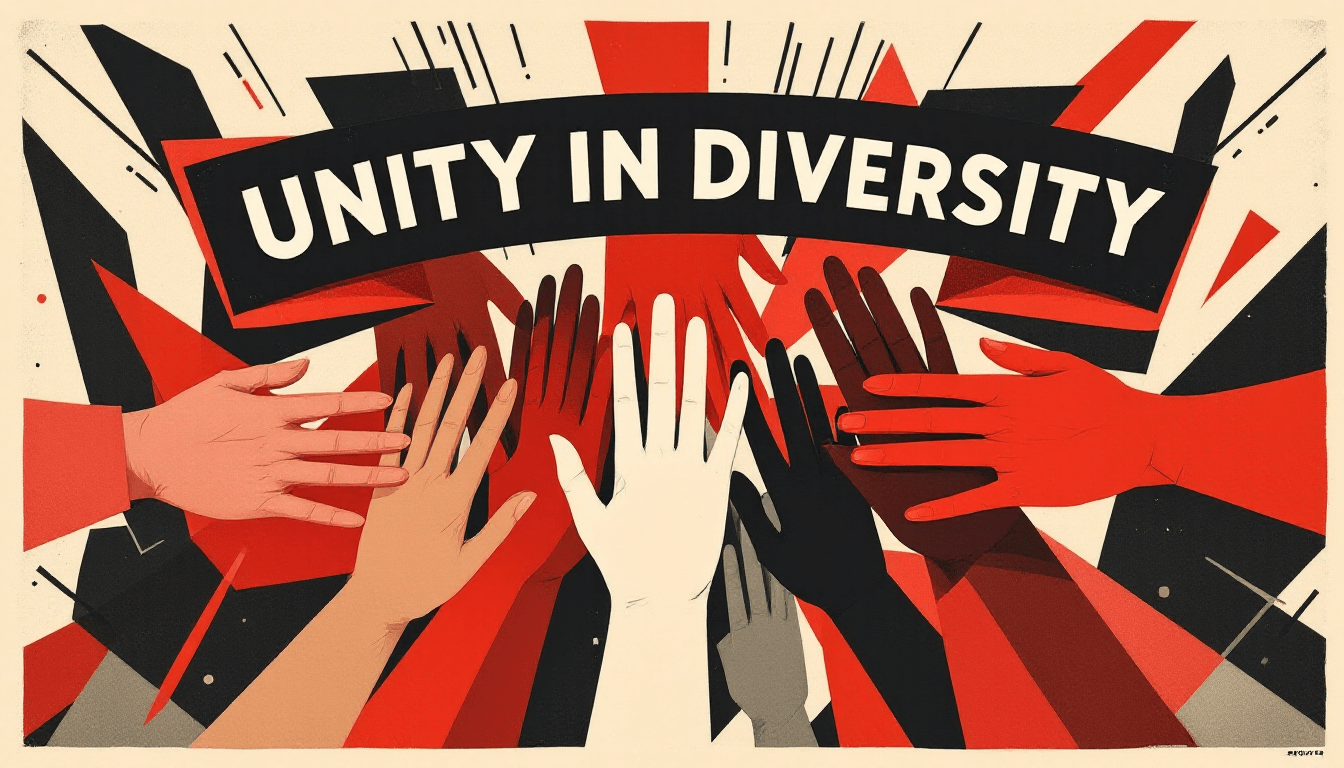Bioleninism: The Ideology Behind Britain's Managed Decline
Bioleninism argues regimes secure power by elevating low-status groups, granting them status or rewards which foster dependence. This loyalty explains identity politics, leftward drift, and enduring regime cohesion in modern Labour governments which is justified by the religion of Intersectionality.

Biological Leninism, or Bioleninism, is a controversial political theory formulated by Neo-reactionary blogger Spandrell in 2017 to explain how progressive regimes acquire and maintain power. Adapting Lenin’s revolutionary strategy to liberal-democratic contexts, it argues that political loyalty is most effectively secured by elevating groups who would otherwise remain low-status in traditional hierarchies.
At its core, Bioleninism proposes a simple mechanism: grant symbolic or material advantage to marginalised groups, creating existential dependency on the order that empowered them. Since these groups have little to gain from alternative arrangements – and everything to lose if the system collapses – they become unusually reliable enforcers of the regime.
The Loyalty Problem
Every political order must solve the same problem: how to secure the loyalty of its elites, managers and security / enforcers. Different regimes, at different times in history, have developed a range of solutions:
- Feudalism: Kinship bonds, oaths, and land grants
- Absolutism: Religious sanction, divine right, and centralised bureaucracy
- Liberalism: Economic contracts, market incentives, and property rights
- Leninism: Elevation of the dispossessed into ruling cadres
Lenin's innovation was recruiting from those with no stake in the existing order — peasants, workers, ethnic minorities, women. These groups owed everything to the Communist Party. If it fell, they would inevitably return to subordination. Their loyalty stemmed not just from ideology or fear, but from rational self-interest: the Party was their only path to status and security.
This explains the durability of Soviet and Chinese communist regimes. The most reliable supporters were those with the most to gain from the system's success / survival, and the most to lose from its collapse.
Status as Political Currency
At its deepest level, Bioleninism draws from evolutionary psychology. Human beings are status-seeking primates whose reproductive success historically depended on social rank. Traits such as intelligence, physical attractiveness, health, or conformity to prevailing norms tend to correlate with higher status. Conversely, those lacking such traits are structurally disadvantaged.
Modern egalitarian systems invert this evolutionary sorting. By elevating those traditionally / biologically disadvantaged — whether through policy, representation, or patronage — Bioleninism taps into primal status drives, converting resentment and exclusion into loyalty. This grounding explains the intensity of identitarian politics: they harness not just material interests but reproductive and existential imperatives.
Humans are intensely status-driven animals. Access to resources, relationships, sex, reproduction, and security depends heavily on social rank, not just material wealth. Most societies naturally develop steep hierarchies, relegating the majority of individuals permanently to subordinate positions. Hierarchies inevitably create resentment pools at the bottom.
Traditional socialism promised to flatten these hierarchies. Leninism operationalised this promise by embedding low-status individuals directly into the power structure through the Party.
Elevating marginal groups — symbolically through recognition / visibility or materially through preferential treatment — generates unusually durable loyalty, far more reliable than that of already-successful individuals. The more marginal the group, the greater its dependence, and thus the stronger its loyalty to the regime.
Loyalty vs Competence
Leninism succeeded in an industrial world where deep class divisions produced acute grievances. Workers and peasants, facing harsh material conditions, readily embraced revolutionary promises. But in the postwar West, prosperity blunted proletarian resentment, and therefore its efficacy as a reservoir of grievance that could be mobilised / curated for power.
However, the strategic logic remained: recruit from low-status groups to build loyal coalitions. Where class no longer sufficed, other traits filled the gap — race, gender, sexuality, disability, physical appearance, or any historically stigmatised marker of disadvantage.
Hence Biological Leninism: a system that redistributes status rather than wealth — although it also redistributed wealth / provided targeted financial incentives and mass subsidy — elevating identities / biological markers rather than classes.
While liberal theory presumes meritocratic competition selects the most capable representatives. In practice, political systems reward obedience over ability, recruiting those least able to defect.
The safest recruits are those with limited alternatives — people who cannot easily thrive outside the extant political system. This creates a systematic bias: naturally high-competence / status individuals (more common on the political Right) are less dependable because they have options.
In contrast, the Left can bind those with nowhere else to go via promising upward mobility and recognition.
Over time, this process produces what appears to be an inevitable "leftward drift." Organisations which successfully recruit from the margins develop stronger discipline and cohesion than those relying on already-successful individuals who might defect when conditions change.
This is not accidental drift: elites consciously prefer dependable loyalty over independent competence, since competence can generate rival power bases.
Testing Cadre Commitment
To distinguish genuine supporters from potential defectors, Bioleninism relies on costly signalling — requiring assent to increasingly radical or counter-intuitive claims. Anyone can affirm obvious truths, but affirming absurdities proves commitment and binds functionaries to the regime.
The Chinese proverb “point deer, make horse” acutely illustrates this logic. An Emperor who could compel his courtiers / officials to call a deer a horse demonstrates his absolute power and their comparative absolute loyalty — not because of any truth-vale of the claim, but because his subordinates' willing submission to an obvious falsehood proved their unfailing loyalty.
Modern progressive orthodoxy functions similarly: the more counter-normative the required belief, the stronger the signal of membership. This explains why progressive positions often seem deliberately provocative — they serve as loyalty tests which separate insiders from outsiders; or in Schmittian terms friends from enemies.
Historical Analogies
Spandrell situates Bioleninism against Chinese imperial history. Dynasties often secured loyalty not by empowering natural aristocrats — who could defect — but by elevating eunuchs, slaves, and outcasts into court administration. These individuals, excluded from ordinary status competition, were wholly dependent on imperial favour.
The parallel with modern Bioleninism is direct: marginalised groups function as contemporary eunuchs, elevated precisely because their lack of alternatives ensures fidelity. Just as Chinese emperors tested loyalty by demanding submission to absurd decrees, modern progressive elites demand assent to counter-normative doctrines, binding subjects through absurd / ritualised demonstration of loyalty.
This logic is not unique to imperial China: Lenin’s elevation of peasants, Stalin’s promotion of humble cadres, and Mao’s reliance on Red Guards all show the same pattern — empower those with nothing to lose, whose loyalty is existential.
Spandrell identifies two distinct forms of Leninist organisation:
Formal Leninism (Soviet Model)
- Single party controls all institutions / orthodoxy
- Bureaucracy, education, media unified under central command
- Once power consolidates, ideological drift can be halted
- Stalin could freeze doctrine and suppress further radicalisation
Distributed Leninism (Western Model)
- No single controlling party / terminal orthodoxy
- Diffuse network of institutions (universities, media, corporations, bureaucracies)
- Shared orthodoxy enforced through social pressure and professional consequences
- No mechanism to halt ideological drift
- Continuous radicalisation ratchet as the system seeks new constituencies
Bioleninism represents / embodies the distributed variant — a perpetually radicalising system without central control / ‘Pope’ or natural stopping point.
An open question is whether Bioleninism is consciously designed or arises emergently. On the one hand, political entrepreneurs deliberately mobilise grievances, recruit the marginal, and reward loyalty over competence. On the other, many aspects of Bioleninism unfold spontaneously, through institutional incentives and feedback loops rather than central planning.
This duality helps explain the system’s resilience: even if individual actors or factions were to pursue different strategies, the underlying evolutionary and institutional logic continually regenerates Bioleninist dynamics. The result is less a conspiracy than an attractor state: power consistently flows toward dependency-based loyalty.
The Mechanics of Institutional Capture
The system operates through predictable cycles:
- Recruitment: Identify low-status groups with legitimate, perceived, or manufactured grievances
- Elevation: Offer symbolic recognition (representation, celebration) and material rewards (jobs, grants, subsidies, sinecures, benefits, preferential treatment)
- Dependency: Elevated groups recognise their status depends on system continuation
- Enforcement: Deploy loyal members in institutional chokepoints (HR departments, academia managers, editorial boards, hiring committees)
- Expansion: Success with one group creates template for recruiting additional constituencies / expansion of the grievance matrix
- Ratchet: Each victory becomes new baseline, generating fresh demands
This explains both the expansion of identity politics and its self-reinforcing momentum. Each success makes the next inclusion easier while making reversal to an earlier state significantly harder and more contentious.
The Coalition of the Fringes
The system faces a logistical problem: potential constituencies are infinite, but material resources are finite. Bioleninism solves this through strategic distribution (expropriation, debt / debasement of the fiscal system):
- Symbolic elevation (widespread): Public recognition, media representation, cultural celebration — cheap to produce and can reach / permeate entire demographic groups
- Material rewards (targeted): High-status jobs via DEI, institutional positions, organisational funding — expensive, erodes competence, but necessary to bind key operatives / loyalty nodes
- Material rewards (widespread): Low-status jobs, access to state benefits, preferential treatment via institutional arrangement and hiring practices — expensive but necessary to bind and stabilise the bottom / biological substrate
This two-tier, high-low system of patronage and dependency, maintains broad coalition support while ensuring crucial personnel remain loyal and committed to the Bioleninist regime.
Symbolic recognition is especially powerful because it costs elites little to produce but yields immense psychological reward for recipients, making it a cheaper and more scalable currency than material redistribution.
Feminists and Islamists, transgender activists and children rights charities, secular progressives and religious minorities, convicted criminals and university professors — these groups often have conflicting interests and values but are nevertheless bound together as a “coalition of the fringes”.
Their unity stems not from shared ideology but from shared vulnerability.
Each understands that their elevated position depends on the system's continued dominance. They are bound not to each other but to the structure which guarantees their status.
This dependency-based cohesion may be more durable than traditional ideological solidarity, with internal competition for preferential treatment within the grievance stack ultimately subordinated to maintaining the Bioleninist coalition / leftwing power.
Global Soft-Power Projection
Bioleninism may represent not just a political strategy but a shift in human selection pressures. By consistently privileging / ameliorating dysgenic traits once deemed maladaptive, the system alters reproductive incentives and cultural prestige hierarchies. Groups elevated / subsidised through Bioleninism acquire greater visibility, protection, and material advantage, altering the fitness landscape.
From this perspective, Bioleninism is not only a means of regime maintenance but also sociobiological transformation, with dysgenic consequences that extend across generations.
Just as the Soviet Union supported international workers' movements, contemporary American progressivism promotes / projects identity politics globally. By backing women's rights, gay rights, minority causes, and dissident movements abroad, it cultivates loyal constituencies, or fifth columns, within rival nations.
This serves dual functions: destabilising foreign governments by subverting their political system / status-hierarchy, while expanding American cultural influence. Bioleninism therefore operates as both domestic coalition-building strategy and an international soft-power tool.
Bioleninism is a powerful binding mechanism but not without fragility:
- Coalition Conflicts: Marginal groups often have mutually incompatible interests. Cohesion relies solely on systemic dependency, not ideological harmony.
- Competence Erosion: By prioritising loyalty over ability, institutions risk long-term dysfunction.
- Exhaustion of Constituencies: As more groups are recruited and elevated, the system must continuously radicalise to find new margins, risking over-extension.
- Crisis Testing: Only under conditions of systemic stress — war, economic collapse, external competition — can the durability of Bioleninist loyalty be proven.
These contradictions suggest that while Bioleninism is resilient, it may be inherently unstable over long time-horizons — especially when confronted by external rivals whose meritocratic or performance-oriented systems out-compete it in war, economics, manufacturing, or technological advancement.
Perhaps the most striking claim is that distributed Leninist systems lack internal brakes / stopping mechanism. Formal communist states eventually consolidated power and could halt ideological escalation. Western systems lack an equivalent mechanism to arrest leftward-drift.
Each successful inclusion creates precedent, momentum, and justification for the next. Each accommodation becomes the new baseline from which further demands are launched. Without a centralising authority — a monarch, pope, or dictator — to declare victory and freeze the process, the ratchet continues, producing perpetual radicalisation.
This explains why progressive politics seems to accelerate rather than moderate over time. It’s why yesterday's radical positions dialectically transition into today's mainstream orthodoxy.
The Recursive Political Algorithm
Stripped to its essence, Bioleninism functions as a simple recursive algorithm:
- Input: Identify low-status groups in existing hierarchies
- Process: Elevate them through symbolic recognition and material benefits
- Output: Generate loyalty through dependency
- Feedback: Deploy loyalists as institutional enforcers
- Iteration: Success creates a template, justification, and momentum, for recruiting additional constituencies
- Amplification: Each cycle expands the coalition and deepens regime control
The elegance lies in its systemic self-reinforcing nature: recruitment generates loyalty, loyalty enables enforcement, enforcement creates conditions for further recruitment / expansion.
An Emerging Theoretical Framework
Bioleninism provides a unified hypothesis for understanding seemingly disparate phenomena — the leftward drift of institutions, the prominence of identity politics, the cohesion of diverse progressive coalitions, and the one-way nature of political / cultural change.
It reframes contemporary progressive politics not as moral crusade or pursuit of justice, but as sophisticated power acquisition strategy. It suggests elevated rhetoric about oppression and equality serves primarily to mask what is essentially an ideologically framed personnel policy — directed towards power acquisition — designed to create loyal institutional cadres / regime apparatchiks.
The theory implies contemporary political movements succeed not by convincing majorities of their righteousness, but by creating dependency relationships with strategically positioned minorities who have strong incentives to maintain and expand the system which benefits them — at the expense of their host civilisation.
Postscript: Evolution To Biotrotskyism
If Bioleninism explains the internal logic of regime consolidation — elevating marginal groups to secure loyalty through dependency — then Biotrotskyism represents its externalised, permanent revolutionary phase. The two are structurally continuous but operate on different registers.
Bioleninism provides a functionalist interpretation of modern progressive politics: build power by elevating the biologically / naturally excluded, bind them through existential status-dependency, deploy them as apparatchiks / enforcers of distributed ideological control.
It explains institutional drift, symbolic politics, and coalition maintenance through the simple principle that the most reliable supporters are those folded into the regimes dependency-matrix / which would suffer loss of status under other merit-based methods of social organisation.
Bioleninism thrives within distributed liberal-democratic / oligarchic systems. Its essential function is to solve the loyalty problem by elevating the marginal, substituting symbolic prestige and selective material rewards for traditional class-based mobilisation. The result is a coalition of the fringes bound by dependency. But Bioleninism presumes relative stability / managed decline: loyalty is purchased and maintained within an already existing order.
Biotrotskyism, by contrast, is the regime’s terminal telos. It extends the Bioleninist mechanism into an endless process of demographic terraformation — mass immigration, substitution, and transvaluation of populations as an instrument of governance.
Where Bioleninism stabilises through marginal recruitment, Biotrotskyism destabilises through perpetual demographic revolution. Its logic is not consolidation but churn facilitating accelerated dispossession: maintaining instability as both governance and expropriation strategy.
This distinction explains their different energetic bases:
- Bioleninism depends on selective recruitment and symbolic elevation. It is parasitic on an existing host population whose dispossession can be managed incrementally.
- Biotrotskyism demands continuous “fracking of the middle” — stripping wealth, rights, and autonomy from the productive strata to fuel an elite–underclass alliance. Systemised dispossession becomes perpetual, as new client populations are imported to displace older ones once their dependency plateaus.
In this sense, Biotrotskyism is Leninism without end: Trotsky’s “permanent revolution” recoded as permanent demographic revolution. It treats instability not as a transitional phase but as the very mode of governance. Where Bioleninism recruits from the fringes to stabilise institutions, Biotrotskyism weaponises population churn to prevent stabilisation altogether.
The key difference is one of trajectory. Bioleninism is a population management mechanism. Biotrotskyism is a demographic revolution as destiny. Bioleninism answers the loyalty problem, while Biotrotskyism transforms loyalty / dependency into a function of demographic chaos. The former creates reliable cadres, the latter ensures there can never be a stable opposition.
Whether or not one accepts its explanation, Bioleninism crystallises important questions about political loyalty, institutional capture, and the relationship between status distribution and power in contemporary liberal-democracies / oligarchies. At minimum, it provides a useful lens for understanding why certain left-wing political movements seem to grow stronger over time while others fragment, and why cultural change often appears to flow primarily in one direction.





